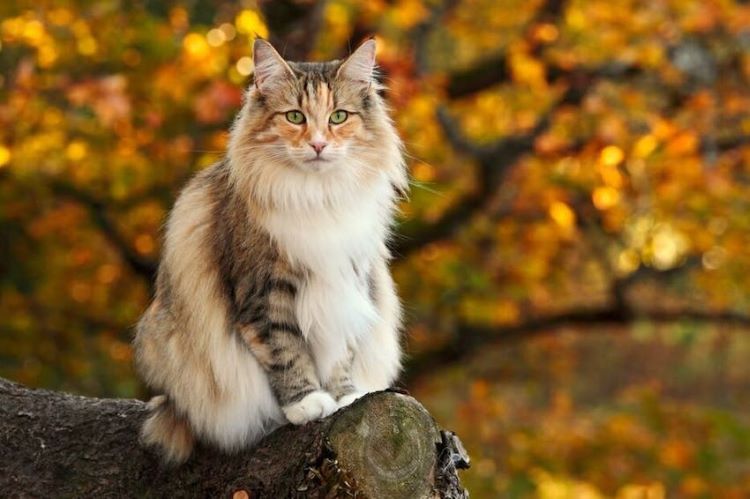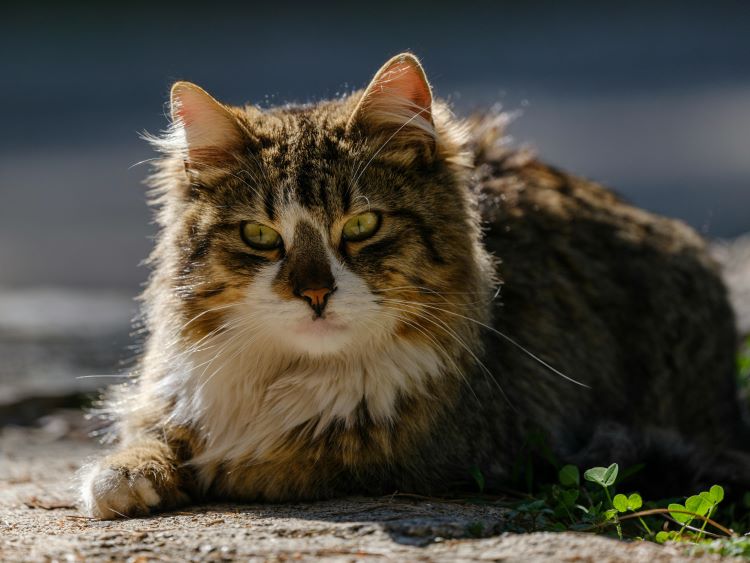Ready to help treat your pet to a healthy life?
All About the Norwegian Forest Cat: a Feline Breed Guide
By : Trupanion Staff | Published May 6, 2025

With their longer coat and large bodies, Norwegian Forest Cats command attention. But what are they exactly? To the unfamiliar, their large size and luxurious fur can easily be mistaken for that of a Maine Coon. But these are two separate cat breeds with unique traits.
Lovingly called the “Wegie” by many aficionados, the Norwegian Forest Cat is known for its gentle and loving nature. But how else can the passionate cat lover tell the difference between a Wegie and other large cat breeds? We’re here to answer all your Norwegian Forest Cat questions and then some!
Let’s kick things off with some facts about why these cats are so cool.
11 interesting facts about the Norwegian Forest Cat
- As the name suggests, these cats are native to Scandinavia. However, they can be found in most parts of the world today.
- When the breed was nearing extinction in the 1970s, Norway developed a special breeding program to save it.
- Norwegian names for this cat include “Norsk skaukatt,” “Norsk granskogkatte,” “Norsk skogkatt,” or simply “Skogkatt” (“forest cat”).
- According to Norse legend, goddess of love, Freya, adored these cats and used them to pull her chariot.
- Because of their mythological history, they are sometimes called “fairy cats.”
- Norwegian Forest Cats are often said to be simultaneously affectionate and aloof.
- Leif Erickson is said to have brought Norwegian Forest Cats to North America around 1000 CE, though they didn’t “officially” arrive in the U.S. until the 1970s.
- Though often confused for Maine Coons, Wegies may actually be their ancestors! After arriving in New England, it is believed they then merged with a local breed, resulting in the Maine Coon.
- One of the largest domesticated cats, they typically are between 12 and 16 pounds (5 – 7 kg). But some have grown even bigger!
- Norwegian Forest Cats are considered a “natural” breed because they initially evolved via natural selection rather than being developed via selective breeding by humans.
- Because of their strong body and claws, Norwegian Forest Cats are agile climbers and can actually climb down trees headfirst!
Where do Norwegian Forest Cats come from?
Norwegian Forest Cats are considered one of the oldest cat breeds in the world. Adapted to the cold weather of Norway and other areas of Northern Europe, their history includes both actual records and a lot of myth and anecdotes. In fact, if you Google the Norwegian Forest Cat’s history, you’re going to see an awful lot of declarations that these cats come from the Norse gods themselves.
Here’s what we do know: the Wegie hails from Norway, and its exact ancestors will likely never be established. However, the Vikings brought back many animals to Norway from their travels, including cats. These likely included the British Shorthair or a similar breed, which eventually merged with a long-haired cat variety (like the Siberian or Turkish Angora) either local to the area or brought there at another point.
Like other cats in Viking times, Wegies served human society as barn and ship cats. As noted, they are believed to have been brought to North America around 1000 CE (possibly with Leif Erikson), but it wasn’t until much later that they made a more formal entrance. More on that in a bit.
Meanwhile in Norway, Norwegian Forest Cats maintained such a high level of popularity that they were named the country’s national cat breed in 1938. Even so, it wasn’t until the 1950s that they would be recognized as an official breed by European cat clubs and thus be eligible for competition.
World War II hindered much of the breed’s travels and even put their existence at risk due to famine and poverty during and after the war. However, lovers of the breed rallied together to save them, and in the 1970s, the Norwegian government stepped in with a special breeding program.
In 1979, the first breeding pair of Wegies was brought to the United States, marking their “official” debut in the new world (despite evidence placing them in North America centuries earlier). Still, it would be another 14 years before they would be recognized by the Cat Fanciers Association (CFA). Since then, representatives of the breed have won many national and international championships with the organization.
Do Norwegian Forest Cats make good pets?
Considering adding a Wegie to the family? As we’ve discussed, Norwegian Forest Cats have long been prominent in Norway and other parts of Scandinavia, but they’ve become one of the most popular cat breeds in North America as well. Lovers of these majestic felines are passionate about them thanks to their delightful personalities and easy-going nature. And, of course, those large, cuddly bodies and beautiful looks don’t hurt!
Temperament and activity levels
Despite their larger size, Wegies are only moderately active and more than happy to entertain themselves with toys and climbing. They tend to be good with other animals and children alike (providing everyone’s been properly introduced), so they can be an excellent cat for families. These easy-going giants are typically adaptable and eager to please and bond.
Energy-wise, Wegies are like other large pet cat breeds in that they are often playful but not hyper, and they tend to rest for long periods. Part of this is due to their origins in colder climates, which called for ample rest to conserve energy and make it through frigid winters. In other words, don’t be surprised if your Wegie snoozes most of the day away!
Still, like all cats they do need regular playtime to stay healthy. The average Norwegian Forest Cat is likely to entertain themselves throughout the day with toys and scratching posts, but regular play time with family will help ensure they’re getting enough exercise.
An important note about Norwegian Forest Cats is that they love to climb. With their large, powerful bodies, they are very adept at scaling walls and furniture. Before welcoming a Wegie into your home, consider investing in a tall cat tree or even wall-mounted cat shelves or you may find Wegie on top of tall furniture or even your cabinets.
Physical traits of the Norwegian Forest Cat
- Height: 9 - 12 inches (22.86 to 30.48 cm)
- Weight: 12 - 16 pounds (5.44 to 7.26 kg), though some can reach over 20 pounds!
As large cats, you can expect to be paying a bit more for cat food and having to choose pet beds and toys that are appropriate for their size. But hey, many cat parents would agree it’s all worth it for the company of a big, friendly feline!
Regarding their general appearance, these beauties have a large, triangular head with large, almond-shaped eyes. Typical Wegie eye colors are green, gold, copper, or a combination thereof, but all-white cats may have blue eyes.
Their double coat is thick and water-resistant, but their top coat is silky and soft. Their long, luxurious coats come in a wide variety of colors and patterns. From solid colors like white or black, to tabby or patched colorings.
Similar cat breeds
- Maine Coon
- Siberian
- Turkish Van
How much grooming do Norwegian Forest Cats need?
Norwegian Forest Cats have a dense undercoat that protects them from the cold, not to mention water and brush in the woods. However, their top coat is silky and smooth, so their grooming needs may be a bit less than other long-haired feline beauties.
That said, they may be more likely to get matting thanks to that undercoat, which will shed more as the seasons change. So they’ll benefit from regular brushing with a slicker brush, and you’ll want to be extra vigilant during spring and fall.

Norwegian Forest Cat health concerns
The Norwegian Forest Cat is considered a generally healthy breed. However, that doesn’t mean there aren’t certain health risks pet owners should be aware of.
Here are some of the more common health issues seen in these cats:
- Hypertrophic Cardiomyopathy — This is the most common heart condition in cats. It can lead to congestive heart failure and other issues. Because the signs of this condition are not obvious, regular vet visits are highly important to catch it early.
- Kidney disease — Norwegian Forest Cats are susceptible to several kidney-related diseases. While signs and symptoms are not always obvious, regular vet screenings can help with early detection and prevent feline kidney failure.
- Joint dysplasia — Their large size and long limbs can lead to joint issues. If you notice limping or avoidance of climbing, speak to your vet.
- Diabetes — Diabetes can be caused by obesity, but it is also genetic. Keeping your cat at a healthy weight and on a healthy diet can help prevent diabetes in some cases.
Regular vet visits are an important part of being a responsible pet parent. And despite their reputation as a healthy breed, Norwegian Forest Cats can still have expensive health issues or even accidents that can be costly. Pet insurance for cats is an excellent way to help with surprise medical costs that come from testing, diagnosis, and even treatment.
Norwegian Forest Cats in pop culture
The Wegie’s biggest claim to fame is its role in Scandinavian folklore and legend. But that doesn’t mean the breed hasn’t earned its place in modern pop culture! In addition to being the subject of numerous social media posts and cat-tastic videos, a Norwegian Forest Cat starred alongside Kevin Spacey, Jennifer Garner, and Christopher Walken in the 2016 film, Nine Lives. In the film, a man finds himself in the body of the cat and as he tries to return to his human form, he rebuilds his relationship with his family.
Enjoy learning about the Norwegian Forest Cat? Check out other cat breed guides and become a pro on the wonderful world of felines.
